|
|
|
Sort Order |
|
|
|
Items / Page
|
|
|
|
|
|
|
| Srl | Item |
| 1 |
ID:
119065
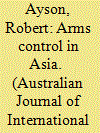

|
|
|
|
|
| Publication |
2013.
|
| Summary/Abstract |
Even if the international mood in favour of steep US and Russian nuclear cuts was to last, it is unlikely to spread to Asia, where nuclear arsenals remain comparatively modest and where regional allies rely on Washington for extended deterrence. This does not render nuclear arms control irrelevant in Asia, where there is a modest but significant tradition based on informal and unilateral restraint rather than formal agreement. But as more of Asia's nuclear programs have come out of the closet and as great power relationships intensify, the region needs to look nuclear arms control more squarely in the eye. For arms control to have real purchase in tomorrow's Asia, China and the USA will need to look beyond their currently asymmetrical relationship and find an understanding based on increased nuclear transparency which also restrains their potentially escalatory competition in advanced conventional war-fighting abilities.
|
|
|
|
|
|
|
|
|
|
|
|
|
|
|
|
| 2 |
ID:
183145
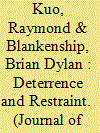

|
|
|
|
|
| Summary/Abstract |
Multinational military exercises are among the most notable demonstrations of military cooperation and intent. On average, one is initiated every 8.9 days. But it has often been argued that joint military exercises (JMEs) increase the risk of war. Using a relational contracting approach, we claim that formal military alliances mediate the effect of JMEs. Exercises and alliances serve complementary functions: The former allows targeted responses to military provocations by adversaries, while the latter provides institutional constraints on partners and establishes a partnership’s overall strategic limitations. In combination, alliances dampen the conflict escalation effects of exercises, deterring adversaries while simultaneously restraining partners. We test this theory using a two-stage model on directed dyadic data of JMEs from 1973 through 2003. We find that JMEs in general do not escalate conflict, and that JMEs conducted with allies in particular reduce the probability of conflict escalation.
|
|
|
|
|
|
|
|
|
|
|
|
|
|
|
|
| 3 |
ID:
132349
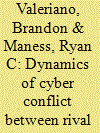

|
|
|
|
|
| Publication |
2014.
|
| Summary/Abstract |
Much discussion of the concept of cyberwar, cyber conflict, and the changing dynamic of future security interactions is founded upon the study of what could be, conjured through spectacular flights of the imagination. The goal of this research article is to exhaustively collect information on cyber interactions between rival states in the last decade so that we can delineate the patterns of cyber conflict as reflected by evidence at the international level. The field of cyber security needs a clear return to social science in order to be able to definitively engage the cyber debate with facts, figures, and theory. To that end we provide a dataset of cyber incidents and cyber disputes that spans from 2001 to 2011. Our data include 110 cyber incidents and 45 cyber disputes. Further, we test our theory of cyber conflict which argues that restraint and regionalism should be expected, counter-intuitive to conventional wisdom. We find here that the actual magnitude and pace of cyber disputes among rivals does not match with popular perception; 20 of 126 active rivals engaged in cyber conflict. The interactions that are uncovered are limited in terms of magnitude and frequency suggesting cyber restraint. Further, most of the cyber disputes that are uncovered are regional in tone, defying the unbounded nature of cyberpower. The coming era of cyber conflict may continue to exhibit these patterns despite fears mentioned in the discourse by the media and cyber security professionals.
|
|
|
|
|
|
|
|
|
|
|
|
|
|
|
|
| 4 |
ID:
163433
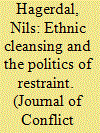

|
|
|
|
|
| Summary/Abstract |
What happens when an armed group has military incentives to engage in ethnic cleansing, but political incentives to abstain? I argue that militants can solve this dilemma by collecting intelligence that allows them to discriminate between neutral and militant non-coethnics and target only the latter. Armed groups are better able to do so in intermixed areas, where loyal coethnics provide intelligence, and thus more likely to perpetrate selective violence in such locations. Homogenous, non-coethnic enclaves are more susceptible to ethnic cleansing as armed groups often have little choice but to use ethnicity as proxy for political loyalties. I elaborate and test this argument using an original data set and extensive interviews on a critical case in the literature on ethnic cleansing: the Lebanese civil war of 1975 to 1990.
|
|
|
|
|
|
|
|
|
|
|
|
|
|
|
|
| 5 |
ID:
181688


|
|
|
|
|
| Summary/Abstract |
Liberalism and its republican precursors provide the largest and best-developed body of restraint theory and practice. Realist, libertarian and other criticisms of liberalism and liberal internationalism fall short on both historical and theoretical grounds. Liberal internationalism has had a profoundly progressive – even revolutionary – impact on the modern world order, advancing the grand transition from a world of empire to a world of nation-states, building an infrastructure of rules and institutions to foster and protect liberal democracy, and generating international coalitions and projects for tackling the gravest threats to world order and humanity. Unlike the schools of thought that make up the Quincy coalition, liberal internationalism places at the centre of its vision the cooperative organisation of international order – led by the United States and other liberal democracies, allies and partners – to defend shared liberal values and manage global problems of interdependence.
|
|
|
|
|
|
|
|
|
|
|
|
|
|
|
|
| 6 |
ID:
073982
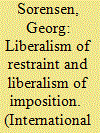

|
|
|
|
|
| Publication |
2006.
|
| Summary/Abstract |
This article seeks to evaluate the prospects for a liberal world order. Sceptical visions of renewed conflict and major terrorist threat are rejected. But this does not pave the way for a peaceful, cooperative liberal order in any simple way. Liberal progress also produces illiberal counter-reactions, and strong political forces are pursuing a liberal order with elements that are essentially illiberal. There has been much too little debate about the substantial contents of a liberal world order. The article identifies two major currents in liberalism, Restraint and Imposition. Each is problematic and a stable liberal world order will have to find a course which avoids the pitfalls of these extremes.
|
|
|
|
|
|
|
|
|
|
|
|
|
|
|
|
| 7 |
ID:
135263
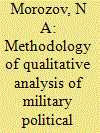

|
|
|
|
|
| Summary/Abstract |
The paper covers the general methodology points of qualitative analysis of military political systems underlying aggregate assessments of possibilities for resolving conflicts and making recommendations for the concepts of weapons (Forces) employment in strategic Operations. It also examines the main tasks of the methodology, and the areas and limits of its application.
|
|
|
|
|
|
|
|
|
|
|
|
|
|
|
|
| 8 |
ID:
160350


|
|
|
|
|
| Summary/Abstract |
This paper seeks to find an answer to the question of why China’s effort to curb
North Korea’s nuclear development has failed to produce expected outcomes.
Since the second North Korean nuclear crisis in 2002, China, as the most, if not
sole, influential country to North Korea, has been attempting to restrain the North’s
nuclear armament. Nevertheless, Beijing has always failed to sustain its pressure
on Pyongyang long enough to restrain Pyongyang’s nuclear ambition; instead, it
has often ended up with China’s appeasement policy. Witnessing such failure, some
scholars assert that Beijing is able, but not willing, to curb Pyongyang’s nuclear
armament, while others claim that Beijing’s leverage over Pyongyang is a lot
more limited than widely thought. Yet, both schools of thought, focusing narrowly
on China’s capability or willingness to restrain North Korea, has failed to depict
a full picture. By contrast, this study, employing a game theory approach, views
Sino–DPRK relations as a strategic interaction between restrainer and restrainee.
It argues that North Korea’s tactical deception and military adventurism shuffle
China’s political priorities on the Korean peninsula, thereby preventing China from
pressuring North Korea.
|
|
|
|
|
|
|
|
|
|
|
|
|
|
|
|
|
|
|
|
|